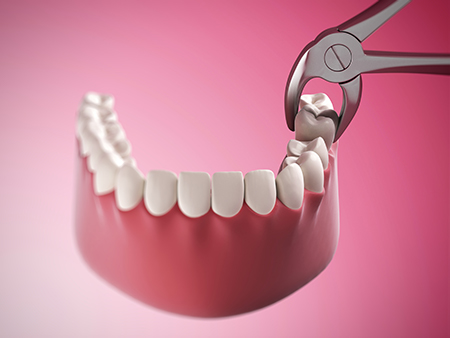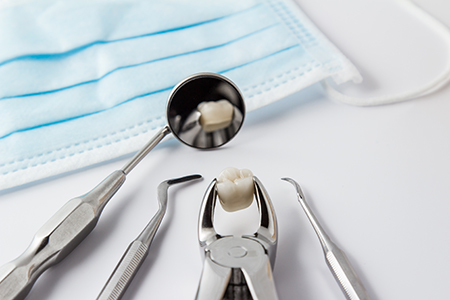
At the office of Lesley Holloway the Dentist, our priority is to protect your long-term oral health while preserving as much of your natural smile as possible. Although our team always explores conservative options first, there are circumstances where removing a tooth is the most responsible clinical choice. We approach those situations with clear communication, careful planning, and a focus on your comfort.
Every recommendation for extraction begins with a thorough evaluation. We review your dental and medical history, examine the area in question, and take digital radiographs when needed to understand the tooth’s roots and the surrounding bone. That assessment helps us determine whether a tooth can be saved with restorative care or if removal is the safest option.
When extraction is recommended, we’ll explain the reasons, the alternatives, and what to expect before, during, and after the procedure. Our goal is to make sure you leave the conversation informed and confident in the treatment plan so that healing and any necessary follow-up care proceed smoothly.
Primary teeth that won’t fall out naturally
Sometimes a baby tooth remains firmly in place because its roots did not resorb properly or because it has fused to the bone. When an over-retained primary tooth interferes with the eruption or alignment of a permanent tooth, removing it can prevent future bite or spacing problems.
Permanent teeth with extensive, non-restorable decay
Decay can advance from the outer enamel into deeper tooth structure and the nerve. If a tooth has lost too much structural integrity and cannot be predictably rebuilt, extraction may be the safest option to eliminate infection and protect adjacent teeth and tissues.
Teeth that are fractured beyond repair
Not all breaks can be fixed. When a tooth is split or broken so severely that there isn’t enough sound structure to support a crown or restoration, removing it prevents ongoing pain, infection, and complications for neighboring teeth.
Teeth compromised by advanced periodontal disease
Periodontal disease attacks the supporting tissues and bone around teeth. If bone loss and looseness reach a point where the tooth no longer has adequate support, extraction may be needed to resolve infection and restore oral health.
Wisdom teeth that are impacted or causing problems
Third molars often lack room to erupt properly. They can become impacted, decay-prone, or push against neighboring teeth. Early removal of problematic wisdom teeth can prevent pain, infection, and damage to adjacent teeth.
Extractions as part of orthodontic planning
In certain orthodontic cases, removing one or more teeth creates the space needed to align the remaining teeth and establish a functional, stable bite. These extractions are planned carefully with consideration for the overall treatment goals.

Before any extraction, we perform a comprehensive review that includes your medical history, current medications, and any concerns about bleeding, heart conditions, or existing health issues. That information guides precautions such as pre-procedure antibiotics or medical clearance if needed. Clear pre-surgical instructions help reduce risk and support a smoother recovery.
Digital radiographs are commonly used to visualize root anatomy, bone level, and the tooth’s relationship to nearby anatomical structures. These images help us decide whether a tooth can be removed simply with forceps or whether a more involved surgical approach is warranted. We’ll share the reasoning and walk you through the steps so you know what to expect.
Local anesthesia is standard to ensure you don’t feel pain during the extraction. For patients who experience anxiety or prefer deeper relaxation, we discuss additional options such as oral or nitrous oxide sedation. Our aim is to balance safety and comfort, providing the level of sedation that best fits the clinical situation and your preferences.
When a tooth is visible in the mouth and the roots are straightforward, the extraction is often called “simple.” After effective local anesthesia, the dentist gently loosens the tooth and removes it using instruments designed to preserve surrounding bone and soft tissue. The procedure is typically quick, and most patients experience minimal discomfort afterward when they follow post-operative recommendations.
Teeth that are impacted, broken at the gumline, or ankylosed may require a surgical extraction. This involves a small incision and, occasionally, the removal of a small amount of bone to access the tooth. In more complex cases—such as deeply impacted wisdom teeth or teeth near vital anatomical structures—we may refer you to an oral and maxillofacial surgeon who specializes in these procedures.

The hours and first few days after an extraction are focused on controlling bleeding, managing swelling, and protecting the developing clot in the socket. Most healing begins quickly, but following recommended care instructions is essential to avoid complications like prolonged bleeding or dry socket.
Rest, limited activity, and short periods of ice application to reduce swelling are helpful in the immediate post-operative period. Eating soft foods, staying hydrated, and avoiding actions that disturb the extraction site—such as rinsing vigorously, spitting, or using a straw—promote stable clot formation and more predictable healing.
We provide clear timelines for when you can resume normal oral hygiene, return to work or school, and progress your diet. If you notice unexpected symptoms—creased or increasing pain, continued heavy bleeding, or signs of infection—contact our office so we can evaluate and advise the appropriate next steps.
Gauze and pressure to control bleeding
Bite gently on the gauze pad placed over the extraction site to apply steady pressure. Change the gauze as instructed, generally after the first hour, and continue to monitor bleeding. A small amount of oozing is normal for up to 24 hours; persistent heavy bleeding should be reported.
Protect numb tissues
Avoid chewing or touching the area while local anesthesia is in effect. Numb lips, cheeks, or tongue are more prone to accidental biting—take care until normal sensation returns.
Medications: antibiotics and pain management
Antibiotics:
If prescribed, take the full course exactly as directed to help prevent or control infection.
Pain relief:
Taking an over-the-counter pain reliever before anesthesia wears off can reduce initial discomfort. If prescription analgesics are provided, follow dosing instructions carefully and avoid combining medications without guidance.
Protect the clot
Refrain from rinsing forcefully, spitting, or using a straw for the first 24–48 hours. These actions can dislodge the clot that is forming in the socket and delay healing.
Manage swelling
Apply an ice pack to the cheek for short intervals during the first day to help control swelling. After 24–48 hours, warm compresses can help if swelling persists.
No smoking
Smoking slows healing and increases the risk of complications. Avoid tobacco for at least a week following surgery.
Dietary precautions
Choose soft, cool foods and avoid hot, spicy, or carbonated beverages initially. Gradually reintroduce firmer foods as comfort and healing permit.
Oral hygiene
Keep the rest of your mouth clean with gentle brushing; after the first 24 hours, you may use a mild saltwater rinse to freshen the area, taking care not to rinse vigorously.
Follow-up care
If sutures were placed or additional monitoring is needed, keep your scheduled follow-up appointment. Timely review helps us confirm proper healing and plan any restorative steps.
If you experience prolonged bleeding, escalating pain, fever, or any other concerning symptoms, contact our office right away so we can assess your condition and provide guidance.

Removing a tooth is often the first step in a broader plan to restore function and esthetics. We discuss replacement options early so you can make an informed decision about what best suits your needs, whether that means a removable solution, a fixed bridge, or a dental implant-supported restoration.
Dentures and fixed bridges can provide reliable function and appearance for many patients. Dental implants offer a long-term solution that helps preserve bone and more closely mimics the natural feel and performance of a tooth. We’ll review the benefits and clinical considerations for each approach, including the timing of restorative work after extraction to support predictable outcomes.
Coordinating care—sometimes involving specialists like oral surgeons or dental labs—ensures that the transition from extraction to restoration is planned with precision. Our team works with you to sequence treatment in a way that aligns with your health, healing timeline, and oral goals.
The office of Lesley Holloway the Dentist emphasizes gentle, evidence-based care delivered with clear explanations and attentive follow-up. We aim to make each procedure as comfortable and efficient as possible, using modern imaging and established clinical protocols to guide decisions and reduce risk.
Whether an extraction is straightforward or requires a surgical approach, our team prioritizes safety, infection control, and pain management. We discuss sedation options when appropriate, coordinate with medical providers when necessary, and provide individualized post-operative instructions to support the best possible recovery.
Aftercare is an important part of our approach. We monitor healing, offer timely follow-up, and help you explore restorative options when you’re ready to replace the missing tooth. That continuity of care helps protect both your oral health and your quality of life.
To learn more about tooth extraction or to discuss a specific dental concern, contact us for more information. Our team is ready to answer your questions and help you make a confident decision about your care.
At Lesley Holloway the Dentist, extractions are recommended when removing a tooth is the most responsible option for protecting long-term oral health. This decision is typically made after considering restorative alternatives, the tooth's structural integrity, and the presence of infection or advanced periodontal disease. We emphasize conservative care but recognize that extraction can prevent worsening problems and protect adjacent teeth and tissues.
Common clinical reasons include extensive decay that cannot be predictably restored, teeth fractured below the gumline, advanced bone loss from periodontal disease, and impacted wisdom teeth causing pain or infection. Extractions may also be part of orthodontic planning or necessary when primary teeth do not exfoliate properly and block permanent tooth eruption. Each case begins with a thorough evaluation so the recommended treatment aligns with your overall oral-health goals.
The decision starts with a comprehensive clinical exam and a review of your medical and dental history. Digital radiographs help assess root anatomy, bone support, and the extent of decay or infection, while an evaluation of the remaining tooth structure determines restorability. We also consider functional factors such as bite, the health of neighboring teeth, and the likelihood of predictable long-term success for restorative treatment.
If restorative procedures like root canal therapy, crowns, or periodontal treatment offer a reliable prognosis, saving the tooth is usually preferred. When structural loss, persistent infection, or medical considerations reduce the chance of a favorable outcome, extraction is recommended to prevent complications. Our team explains the reasoning, reviews alternatives, and outlines next steps so you can make an informed choice.
A simple extraction is performed when a tooth is visible in the mouth and has a straightforward root structure, allowing removal with forceps after local anesthesia. These procedures are generally quick and focus on preserving surrounding bone and soft tissue for optimal healing. Most patients experience manageable discomfort afterward, especially when they follow post-operative instructions.
Surgical extractions are required for teeth that are impacted, broken at or below the gumline, or otherwise difficult to access and may involve a small incision and removal of minimal bone. Surgical cases can be more complex and sometimes require sutures or a referral to an oral and maxillofacial surgeon when anatomy or risk factors warrant specialist care. Your dentist will recommend the most appropriate approach and discuss any additional steps needed to support safe removal and recovery.
No, wisdom teeth are not always removed; the decision depends on their position, likelihood of eruption, and whether they pose a risk to oral health. If third molars are fully erupted, functional, and maintainable with routine hygiene, monitoring may be a reasonable alternative to extraction. However, impacted or partially erupted wisdom teeth that trap food, cause decay, crowd adjacent teeth, or lead to infection are often recommended for removal.
Early evaluation with radiographs allows us to predict potential problems and recommend timely treatment when needed to prevent pain or damage to neighboring teeth. When removal is advised, we discuss the timing, technique, and sedation options so you understand the procedure and recovery expectations. This proactive approach can reduce the risk of more complicated surgery later in life.
Primary teeth that remain in place after the expected exfoliation window can interfere with permanent tooth eruption and alignment, so careful assessment is important. We evaluate root resorption, tooth mobility, and the position of the developing permanent tooth with clinical exams and radiographs to determine the best course of action. If the retained primary tooth is obstructing eruption or posing a risk to the developing dentition, extraction is often recommended to support normal growth.
In pediatric cases we prioritize gentle communication and age-appropriate behavior management to make the visit as stress-free as possible. Local anesthesia or mild sedation may be used for comfort, and we provide clear post-operative instructions to support healing and guide parents on diet and oral hygiene. Coordination with your child's dentist or orthodontist helps ensure timing aligns with broader treatment or monitoring plans.
Local anesthesia is the standard method to eliminate pain during most extractions and is sufficient for simple procedures in many patients. We carefully review your medical history, medications, and anxiety level before recommending any additional sedation. Options such as nitrous oxide or oral sedatives may be offered to promote relaxation without compromising safety.
For patients with greater anxiety or for more complex surgical cases, deeper sedation administered by qualified personnel can be considered, always with appropriate monitoring and emergency preparedness. The choice of sedation balances the clinical requirements, patient health, and preferences while following established safety protocols. Your care team will explain benefits, risks, and pre-procedure instructions so you arrive prepared and informed.
If medical conditions or medications could affect anesthesia, we may request medical clearance or adjust the plan to reduce risk. Transparent communication about your health history and any prior reactions to anesthesia helps us tailor a safe plan. Our priority is to provide effective pain control and a comfortable experience while maintaining patient safety at every step.
In the immediate post-operative period, focus on controlling bleeding, reducing swelling, and protecting the blood clot that forms in the socket. Bite gently on gauze as instructed, rest, limit physical activity, and apply short intervals of ice to the cheek to manage swelling. Avoid rinsing vigorously, spitting, or using a straw, as these actions can dislodge the clot and delay healing.
Stick to soft, cool foods and stay well hydrated while your mouth is numb and sensitive, gradually reintroducing firmer items as comfort allows. Take prescribed antibiotics or pain medications exactly as directed, and use over-the-counter analgesics if recommended to maintain comfort. If you notice increasing pain, heavy bleeding, fever, or other concerning symptoms, contact the office promptly for evaluation.
To lower the chance of dry socket, follow post-operative instructions closely by avoiding actions that disturb the clot, such as vigorous rinsing, spitting, or drinking through a straw for the first 24 to 48 hours. Refrain from smoking and using tobacco products for at least a week, as tobacco use significantly increases complication risk and delays healing. Keep the rest of your mouth clean with gentle brushing and then begin gentle saltwater rinses after the first 24 hours as recommended.
Manage pain and swelling with prescribed or recommended medications and use cold then warm compresses as directed to support recovery. Attend any scheduled follow-up appointments so your dentist can assess healing and intervene early if problems arise. Prompt communication with your care team about unexpected symptoms helps reduce the severity of complications when they occur.
Timing for tooth replacement depends on the type of extraction, the presence of infection, and healing progress, with some restorations possible soon after healing and others requiring a longer waiting period. Immediate temporary solutions such as removable partials can provide esthetics and function while healing continues and a long-term plan is developed. Your dentist will discuss a timeline that balances tissue healing, bone preservation, and the chosen restorative method.
Permanent options include fixed bridges, removable dentures, and dental implants, each with distinct clinical considerations and benefits. Implants provide a long-term solution that helps preserve bone and mimic the feel and function of natural teeth, while bridges and dentures may be appropriate when implants are not recommended or desired. We review the advantages, clinical requirements, and expected sequence of care for each option so you can choose the best path forward.
In cases where implants are planned, bone grafting or a healing period may be necessary to ensure adequate support for the implant fixture. Coordinating with specialists, labs, and imaging services helps create predictable outcomes and a smooth transition from extraction to restoration. Your care team will outline follow-up steps and timing to help you understand the overall treatment plan and what to expect at each stage.
A referral to an oral and maxillofacial surgeon is considered when the extraction involves complex anatomy, deeply impacted teeth, proximity to vital structures, or when specialized surgical expertise is required. We also refer patients with certain medical conditions or those who need advanced sedation beyond the scope of the general office to ensure the highest level of safety and care. Referrals are made to support predictable outcomes and to minimize risk in technically challenging cases.
At the office of Lesley Holloway the Dentist we coordinate care with experienced specialists when appropriate and provide comprehensive records, imaging, and clinical context to ensure seamless treatment. Your dentist will explain the reasons for referral, what to expect from the specialist, and how post-operative care will be managed between providers. This collaborative approach helps maintain continuity of care and supports the best possible recovery and restorative planning.
Quick Links
Contact Us